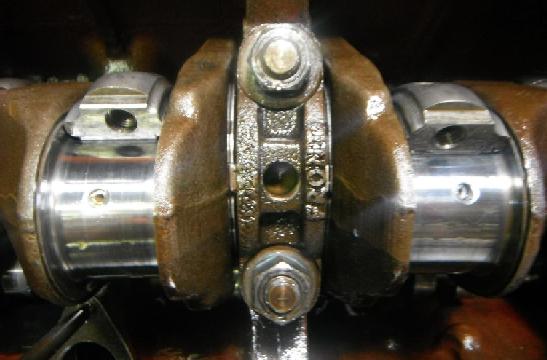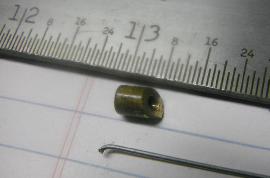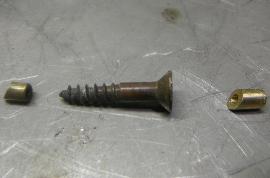The MGA With An Attitude
OIL FLOW RESTRICTORS - CS-101
in the Crankshaft Rod Journals
At 09:34 PM 3/19/04 -0500, Tony Cox wrote:
>"I have just had the crank reground. During the process a brass plug with a hole in it came out of one of the connecting rod journals. These parts are not available but do show on the original factory parts books. Any idea why they are there and are they absolutely necessary."
The crankshaft has angled holes drilled from the main bearing journals to the rod bearing journals to supply oil to the rod bearings. This hole emerges on the outboard side of the rod journl. With some engines that's all you get. For the MG engines there is another hole drilled from the outboard side to the inboard side of the rod journal to improve oil supply to the rod bearing. This is call "cross drilled", resulting in two oil supply holes in each rod journal. At high speed the centrifugal force wants to push most of the oil out through the outside hole, while the hole closer to the central axis of the crankshaft would pass very little oil. The brass part is a small orifice intended to restrict flow through the outer hole to force a more equal amount of oil to flow through the hole closer to the central rotational axis.

In the photo above, the journal on right has the flat nose brass restrictor pressed in below the surface in correct position. For the journal on left, the brass restrictor has come loose and is moved out to where it would contact the connecting rod bearing. This eventually causes the brass piece to wear until the end matches the contour of the rod bearing. It often also wears a matching groove in the soft bearing material. By that time it may be almost totally stopping oil flow at that end of the port in the journal. Oil can still flow out the other end of the cross drilled hole, so the rod bearing still gets oil, but total oil flow may be somewhat reduced.
I have never known exactly how important it is, but I have always been conservative enough to replace any missing part. The brass bits are not difficult to make. Engine shops are always making press fit brass plugs to close off oil gallery drillings in the block. The only difference here is that this plug has a 3/32-inch diameter (0.094-in = 2.38-mm) hole drilled through it. Make the plug 0.001" to 0.002" larger than the hole to be a tight press fit. Tap it into place using a punch to drive it below the surface. The hole in the new part can be drilled before installation, but should also be chased out after installation (in case a burr was raised in the process which would decrease the bore of the restrictor).
Photo at left shows the loose and worn restrictor after removal. Photo at right shows the old one and a new one which was made from a brass wood screw. The maker had cut the end at an angle to roughly match the worn part, but that is not necessary. Leave it square across, and press it in below the surface of the journal. It is important that the brass piece be tight interference fit so it cannot come loose with centrifugal force during high speed running.


I once had one of those restrictors come loose while the engine was running. I have no idea how long it had been loose, but it was quite evident when the engine was later disassembled (for some other reason). The brass part had the end worn off to conform to the contour of the bearing, and the bearing had a groove worn in it all the way around equal to the width of the restrictor, through the white metal but not through the copper underplating. The rest of the surface of the bearing was still in good condition, and there was no damage to the journal on the crankshaft.
These engines are generally quite tolerant of abuse. I have know them to occasionally be assembled with no restrictors in the crankshaft, and they don't seem to suffer any ill effects. My best guess is that it is more important when the engine gets old and worn with larger clearances in the bearings. But I never let the rod bearings get very loose anyway. When an engine gets down to 20 psi oil pressure at idle I install new bearings (well before it would knock), and all is well with the world.
|